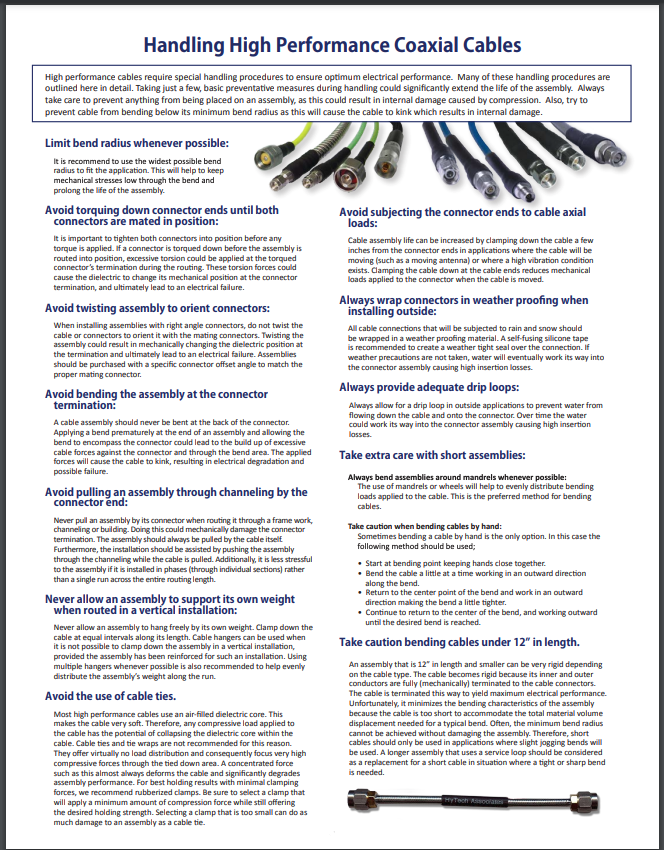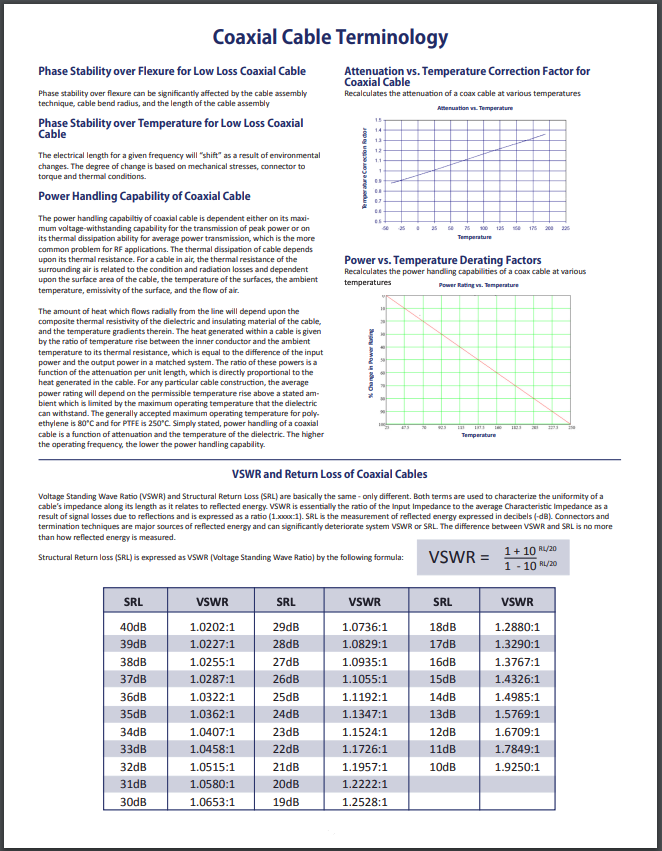Handling High Performance Coax Cables
High performance cables require special handling procedures to ensure optimum electrical performance. Many of these handling procedures are outlined here in detail. Taking just a few, basic preventative measures during handling could significantly extend the life of the assembly. Always take care to prevent anything from being placed on an assembly, as this could result in internal damage caused by compression. Also, try to prevent cable from bending below its minimum bend radius as this will cause the cable to kink which results in internal damage.
|
Click the images below to download a FREE PDF of "Handling High Performance Coaxial Cables and Coaxial Cable Terminology"
Limit bend radius whenever possible It is recommend to use the widest possible bend radius to fit the application. This will help to keep mechanical stresses low through the bend and prolong the life of the assembly.
Avoid torquing down connector ends until both connectors are mated in position
It is important to tighten both connectors into position before any torque is applied. If a connector is torqued down before the assembly is routed into position, excessive torsion could be applied at the torqued connector’s termination during the routing. These torsion forces could cause the dielectric to change its mechanical position at the connector termination, and ultimately lead to an electrical failure. Avoid twisting assembly to orient connectors When installing assemblies with right angle connectors, do not twist the cable or connectors to orient it with the mating connectors. Twisting the assembly could result in mechanically changing the dielectric position at the termination and ultimately lead to an electrical failure. Assemblies should be purchased with a specific connector offset angle to match the proper mating connector. Avoid bending the assembly at the connector termination A cable assembly should never be bent at the back of the connector. Applying a bend prematurely at the end of an assembly and allowing the bend to encompass the connector could lead to the build up of excessive cable forces against the connector and through the bend area. The applied forces will cause the cable to kink, resulting in electrical degradation and possible failure. Avoid pulling an assembly through channeling by the connector end Never pull an assembly by its connector when routing it through a frame work, channeling or building. Doing this could mechanically damage the connector termination. The assembly should always be pulled by the cable itself. Furthermore, the installation should be assisted by pushing the assembly through the channeling while the cable is pulled. Additionally, it is less stressful to the assembly if it is installed in phases (through individual sections) rather than a single run across the entire routing length.
Never allow an assembly to support its own weight when routed in a vertical installation Never allow an assembly to hang freely by its own weight. Clamp down the cable at equal intervals along its length. Cable hangers can be used when it is not possible to clamp down the assembly in a vertical installation, provided the assembly has been reinforced for such an installation. Using multiple hangers whenever possible is also recommended to help evenly distribute the assembly’s weight along the run.
|
Avoid the use of cable ties Most high performance cables use an air-filled dielectric core. This makes the cable very soft. Therefore, any compressive load applied to the cable has the potential of collapsing the dielectric core within the cable. Cable ties and tie wraps are not recommended for this reason. They offer virtually no load distribution and consequently focus very high compressive forces through the tied down area. A concentrated force such as this almost always deforms the cable and significantly degrades assembly performance. For best holding results with minimal clamping forces, we recommend rubberized clamps. Be sure to select a clamp that will apply a minimum amount of compression force while still offering the desired holding strength. Selecting a clamp that is too small can do as much damage to an assembly as a cable tie.
Avoid subjecting the connector ends to cable axial loads
Cable assembly life can be increased by clamping down the cable a few inches from the connector ends in applications where the cable will be moving (such as a moving antenna) or where a high vibration condition exists. Clamping the cable down at the cable ends reduces mechanical loads applied to the connector when the cable is moved.
Always wrap connectors in weather proofing when installing outside
All cable connections that will be subjected to rain and snow should be wrapped in a weather proofing material. A self-fusing silicone tape is recommended to create a weather tight seal over the connection. If weather precautions are not taken, water will eventually work its way into the connector assembly causing high insertion losses. Always provide adequate drip loops
Always allow for a drip loop in outside applications to prevent water from flowing down the cable and onto the connector. Over time the water could work its way into the connector assembly causing high insertion losses.
Take extra care with short assemblies
Always bend assemblies around mandrels whenever possible
Take caution when bending cables by hand
Take caution bending cables under 12” in length
An assembly that is 12” in length and smaller can be very rigid depending on the cable type. The cable becomes rigid because its inner and outer conductors are fully (mechanically) terminated to the cable connectors. The cable is terminated this way to yield maximum electrical performance. Unfortunately, it minimizes the bending characteristics of the assembly because the cable is too short to accommodate the total material volume displacement needed for a typical bend. Often, the minimum bend radius cannot be achieved without damaging the assembly. Therefore, short cables should only be used in applications where slight jogging bends will be used. A longer assembly that uses a service loop should be considered as a replacement for a short cable in situation where a tight or sharp bend is needed. |







